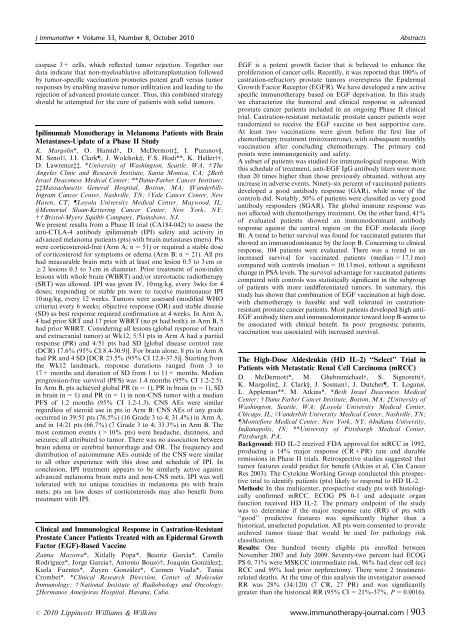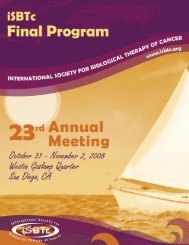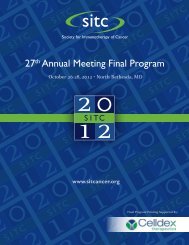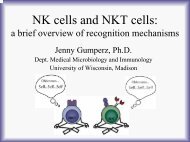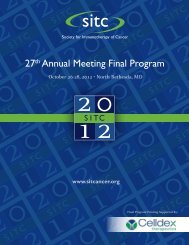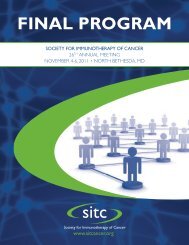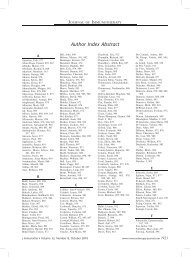Abstracts for the 25th Annual Scientific Meeting of the International ...
Abstracts for the 25th Annual Scientific Meeting of the International ...
Abstracts for the 25th Annual Scientific Meeting of the International ...
Create successful ePaper yourself
Turn your PDF publications into a flip-book with our unique Google optimized e-Paper software.
J Immuno<strong>the</strong>r Volume 33, Number 8, October 2010<br />
<strong>Abstracts</strong><br />
caspase 3+ cells, which reflected tumor rejection. Toge<strong>the</strong>r our<br />
data indicate that non-myeloablative allotransplantation followed<br />
by tumor-specific vaccination promotes potent graft versus tumor<br />
responses by enabling massive tumor infiltration and leading to <strong>the</strong><br />
rejection <strong>of</strong> advanced prostate cancer. Thus, this combined strategy<br />
should be attempted <strong>for</strong> <strong>the</strong> cure <strong>of</strong> patients with solid tumors.<br />
Ipilimumab Mono<strong>the</strong>rapy in Melanoma Patients with Brain<br />
Metastases-Update <strong>of</strong> a Phase II Study<br />
K. Margolin*, O. Hamidw, D. McDermottz, I. Puzanovy,<br />
M. SznolJ, J.I. Clarkz, J. Wolchok#, F.S. Hodi**, K. Hellerww,<br />
D. Lawrencezz. *University <strong>of</strong> Washington, Seattle, WA; w The<br />
Angeles Clinic and Research Institute, Santa Monica, CA; zBeth<br />
Israel Deaconess Medical Center; **Dana-Farber Cancer Institute;<br />
zzMassachusetts General Hospital, Boston, MA; yVanderbilt-<br />
Ingram Cancer Center, Nashville, TN; JYale Cancer Center, New<br />
Haven, CT; zLoyola University Medical Center, Maywood, IL;<br />
#Memorial Sloan-Kettering Cancer Center, New York, NY;<br />
wwBristol-Myers Squibb Company, Plainsboro, NJ.<br />
We present results from a Phase II trial (CA184-042) to assess <strong>the</strong><br />
anti-CTLA-4 antibody ipilimumab (IPI) safety and activity in<br />
advanced melanoma patients (pts) with brain metastases (mets). Pts<br />
were corticosteroid-free (Arm A; n = 51) or required a stable dose<br />
<strong>of</strong> corticosteroid <strong>for</strong> symptoms or edema (Arm B; n = 21). All pts<br />
had measurable brain mets with at least one lesion 0.5 to 3 cm or<br />
Z2 lesions 0.3 to 3 cm in diameter. Prior treatment <strong>of</strong> non-index<br />
lesions with whole brain (WBRT) and/or stereotactic radio<strong>the</strong>rapy<br />
(SRT) was allowed. IPI was given IV, 10 mg/kg, every 3wks <strong>for</strong> 4<br />
doses; responding or stable pts were to receive maintenance IPI<br />
10 mg/kg, every 12 weeks. Tumors were assessed (modified WHO<br />
criteria) every 6 weeks; objective response (OR) and stable disease<br />
(SD) as best response required confirmation at 4 weeks. In Arm A,<br />
4 had prior SRT and 17 prior WBRT (no pt had both); in Arm B, 5<br />
had prior WBRT. Considering all lesions (global response <strong>of</strong> brain<br />
and extracranial tumor) at Wk12, 5/51 pts in Arm A had a partial<br />
response (PR) and 4/51 pts had SD [global disease control rate<br />
(DCR) 17.6% (95% CI 8.4-30.9)]. For brain alone, 8 pts in Arm A<br />
had PR and 4 SD [DCR 23.5% (95% CI 12.8-37.5)]. Starting from<br />
<strong>the</strong> Wk12 landmark, response durations ranged from 3 to<br />
17+ months and duration <strong>of</strong> SD from 1 to 11+ months. Median<br />
progression-free survival (PFS) was 1.4 months (95% CI 1.2-2.5).<br />
In Arm B, pts achieved global PR (n = 1), PR in brain (n = 1), SD<br />
in brain (n = 1) and PR (n = 1) in non-CNS tumor with a median<br />
PFS <strong>of</strong> 1.2 months (95% CI 1.2-1.3). CNS AEs were similar<br />
regardless <strong>of</strong> steroid use in pts in Arm B: CNS AEs <strong>of</strong> any grade<br />
occurred in 39/51 pts (76.5%) (16 Grade 3 to 4; 31.4%) in Arm A,<br />
and in 14/21 pts (66.7%) (7 Grade 3 to 4; 33.3%) in Arm B. The<br />
most common events (>10% pts) were headache, dizziness, and<br />
seizures; all attributed to tumor. There was no association between<br />
brain edema or cerebral hemorrhage and OR. The frequency and<br />
distribution <strong>of</strong> autoimmune AEs outside <strong>of</strong> <strong>the</strong> CNS were similar<br />
to all o<strong>the</strong>r experience with this dose and schedule <strong>of</strong> IPI. In<br />
conclusion, IPI treatment appears to be similarly active against<br />
advanced melanoma brain mets and non-CNS mets. IPI was well<br />
tolerated with no unique toxicities in melanoma pts with brain<br />
mets; pts on low doses <strong>of</strong> corticosteroids may also benefit from<br />
treatment with IPI.<br />
Clinical and Immunological Response in Castration-Resistant<br />
Prostate Cancer Patients Treated with an Epidermal Growth<br />
Factor (EGF)-Based Vaccine<br />
Zaima Mazorra*, Xitlally Popa*, Beatriz García*, Camilo<br />
Rodríguez*, Jorge Garcíaw, Antonio Bouzów, Joaquín Gonzálezz,<br />
Karla Fuentes*, Zuyen González*, Carmen Viada*, Tania<br />
Crombet*. *Clinical Research Direction, Center <strong>of</strong> Molecular<br />
Immunology; w National Institute <strong>of</strong> Radiobiology and Oncology;<br />
zHermanos Ameijeiras Hospital, Havana, Cuba.<br />
EGF is a potent growth factor that is believed to enhance <strong>the</strong><br />
proliferation <strong>of</strong> cancer cells. Recently, it was reported that 100% <strong>of</strong><br />
castration-refractory prostate tumors overexpress <strong>the</strong> Epidermal<br />
Growth Factor Receptor (EGFR). We have developed a new active<br />
specific immuno<strong>the</strong>rapy based on EGF deprivation. In this study<br />
we characterize <strong>the</strong> humoral and clinical response in advanced<br />
prostate cancer patients included in an ongoing Phase II clinical<br />
trial. Castration-resistant metastatic prostate cancer patients were<br />
randomized to receive <strong>the</strong> EGF vaccine or best supportive care.<br />
At least two vaccinations were given be<strong>for</strong>e <strong>the</strong> first line <strong>of</strong><br />
chemo<strong>the</strong>rapy treatment (mitoxantrone), with subsequent monthly<br />
vaccination after concluding chemo<strong>the</strong>rapy. The primary end<br />
points were immunogenicity and safety.<br />
A subset <strong>of</strong> patients was studied <strong>for</strong> immunological response. With<br />
this schedule <strong>of</strong> treatment, anti-EGF IgG antibody titers were more<br />
than 20 times higher than those previously obtained, without any<br />
increase in adverse events. Ninety-six percent <strong>of</strong> vaccinated patients<br />
developed a good antibody response (GAR), while none <strong>of</strong> <strong>the</strong><br />
controls did. Notably, 50% <strong>of</strong> patients were classified as very good<br />
antibody responders (SGAR). The global immune response was<br />
not affected with chemo<strong>the</strong>rapy treatment. On <strong>the</strong> o<strong>the</strong>r hand, 41%<br />
<strong>of</strong> evaluated patients showed an immunodominant antibody<br />
response against <strong>the</strong> central region on <strong>the</strong> EGF molecule (loop<br />
B). A trend to better survival was found <strong>for</strong> vaccinated patients that<br />
showed an immunodominance by <strong>the</strong> loop B. Concerning to clinical<br />
response, 104 patients were evaluated. There was a trend to an<br />
increased survival <strong>for</strong> vaccinated patients (median = 17.1 mo)<br />
compared with controls (median = 10.13 mo), without a significant<br />
change in PSA levels. The survival advantage <strong>for</strong> vaccinated patients<br />
compared with controls was statistically significant in <strong>the</strong> subgroup<br />
<strong>of</strong> patients with more undifferentiated tumors. In summary, this<br />
study has shown that combination <strong>of</strong> EGF vaccination at high dose,<br />
with chemo<strong>the</strong>rapy is feasible and well tolerated in castrationresistant<br />
prostate cancer patients. Most patients developed high anti-<br />
EGF antibody titers and immunodominance toward loop B seems to<br />
be associated with clinical benefit. In poor prognostic patients,<br />
vaccination was associated with increased survival.<br />
The High-Dose Aldesleukin (HD IL-2) ‘‘Select’’ Trial in<br />
Patients with Metastatic Renal Cell Carcinoma (mRCC)<br />
D. McDermott*, M. Ghebremichaelw, S. Signorettiw,<br />
K. Margolinz, J. Clarky, J. SosmanJ, J. Dutcherz, T. Logan#,<br />
L. Appleman**, M. Atkins*. *Beth Israel Deaconess Medical<br />
Center; w Dana Farber Cancer Institute, Boston, MA; zUniversity <strong>of</strong><br />
Washington, Seattle, WA; yLoyola University Medical Center,<br />
Chicago, IL; JVanderbilt University Medical Center, Nashville, TN;<br />
zMontefiore Medical Center, New York, NY; #Indiana University,<br />
Indianapolis, IN; **University <strong>of</strong> Pittsburgh Medical Center,<br />
Pittsburgh, PA.<br />
Background: HD IL-2 received FDA approval <strong>for</strong> mRCC in 1992,<br />
producing a 14% major response (CR+PR) rate and durable<br />
remissions in Phase II trials. Retrospective studies suggested that<br />
tumor features could predict <strong>for</strong> benefit (Atkins et al, Clin Cancer<br />
Res 2003). The Cytokine Working Group conducted this prospective<br />
trial to identify patients (pts) likely to respond to HD IL-2.<br />
Methods: In this multicenter, prospective study pts with histologically<br />
confirmed mRCC, ECOG PS 0-1 and adequate organ<br />
function received HD IL-2. The primary endpoint <strong>of</strong> <strong>the</strong> study<br />
was to determine if <strong>the</strong> major response rate (RR) <strong>of</strong> pts with<br />
‘‘good’’ predictive features was significantly higher than a<br />
historical, unselected population. All pts were consented to provide<br />
archived tumor tissue that would be used <strong>for</strong> pathology risk<br />
classification.<br />
Results: One hundred twenty eligible pts enrolled between<br />
November 2007 and July 2009. Seventy-two percent had ECOG<br />
PS 0, 71% were MSKCC intermediate risk, 96% had clear cell (cc)<br />
RCC and 99% had prior nephrectomy. There were 2 treatmentrelated<br />
deaths. At <strong>the</strong> time <strong>of</strong> this analysis <strong>the</strong> investigator assessed<br />
RR was 28% (34/120) (7 CR, 27 PR) and was significantly<br />
greater than <strong>the</strong> historical RR (95% CI = 21%-37%, P = 0.0016).<br />
r 2010 Lippincott Williams & Wilkins www.immuno<strong>the</strong>rapy-journal.com | 903


